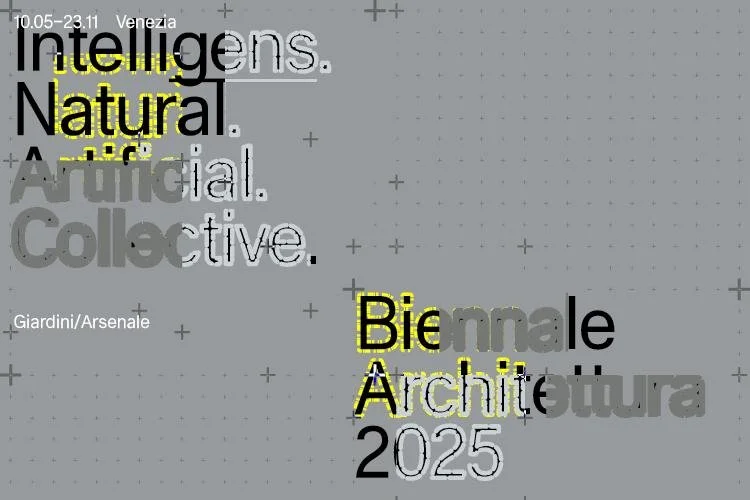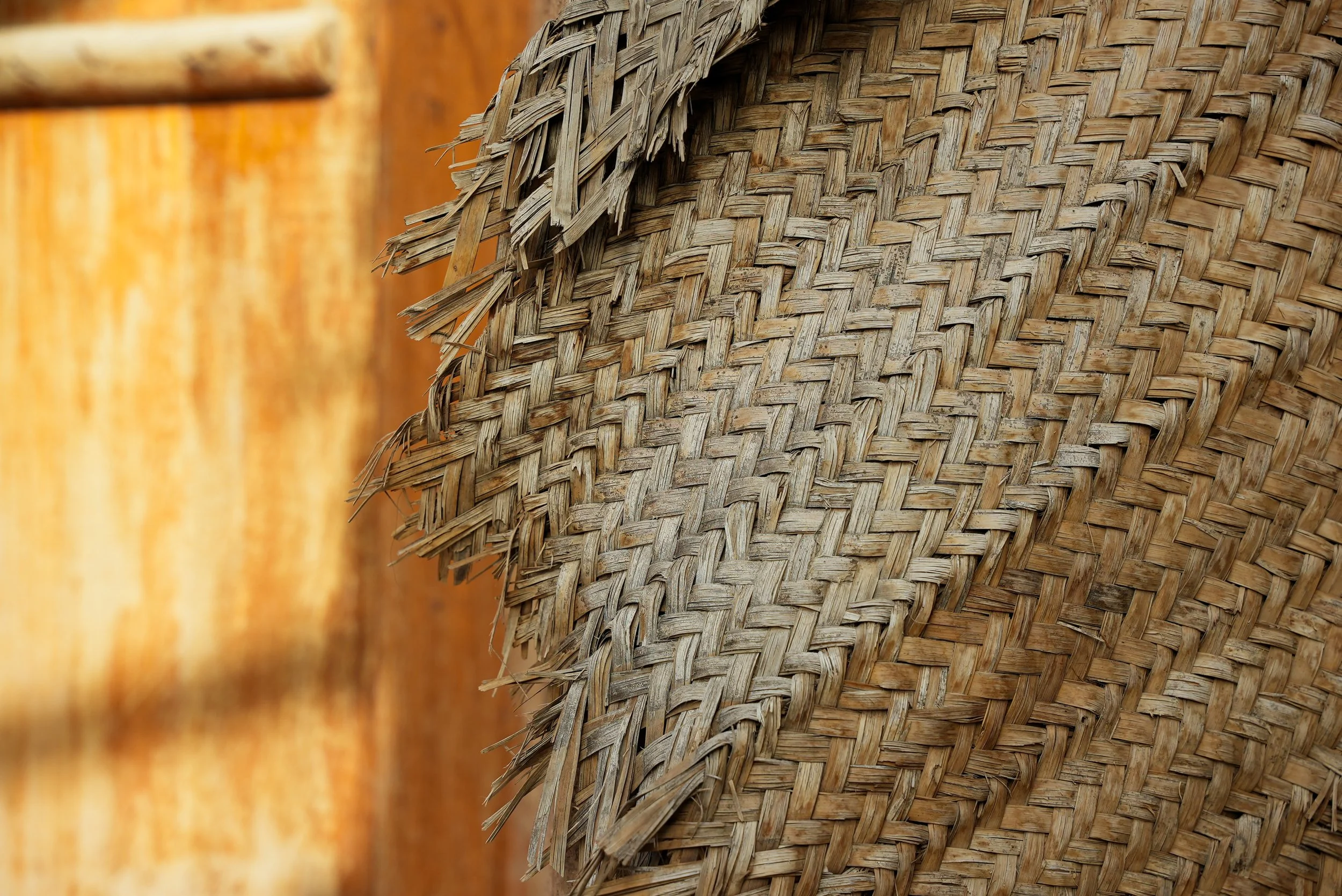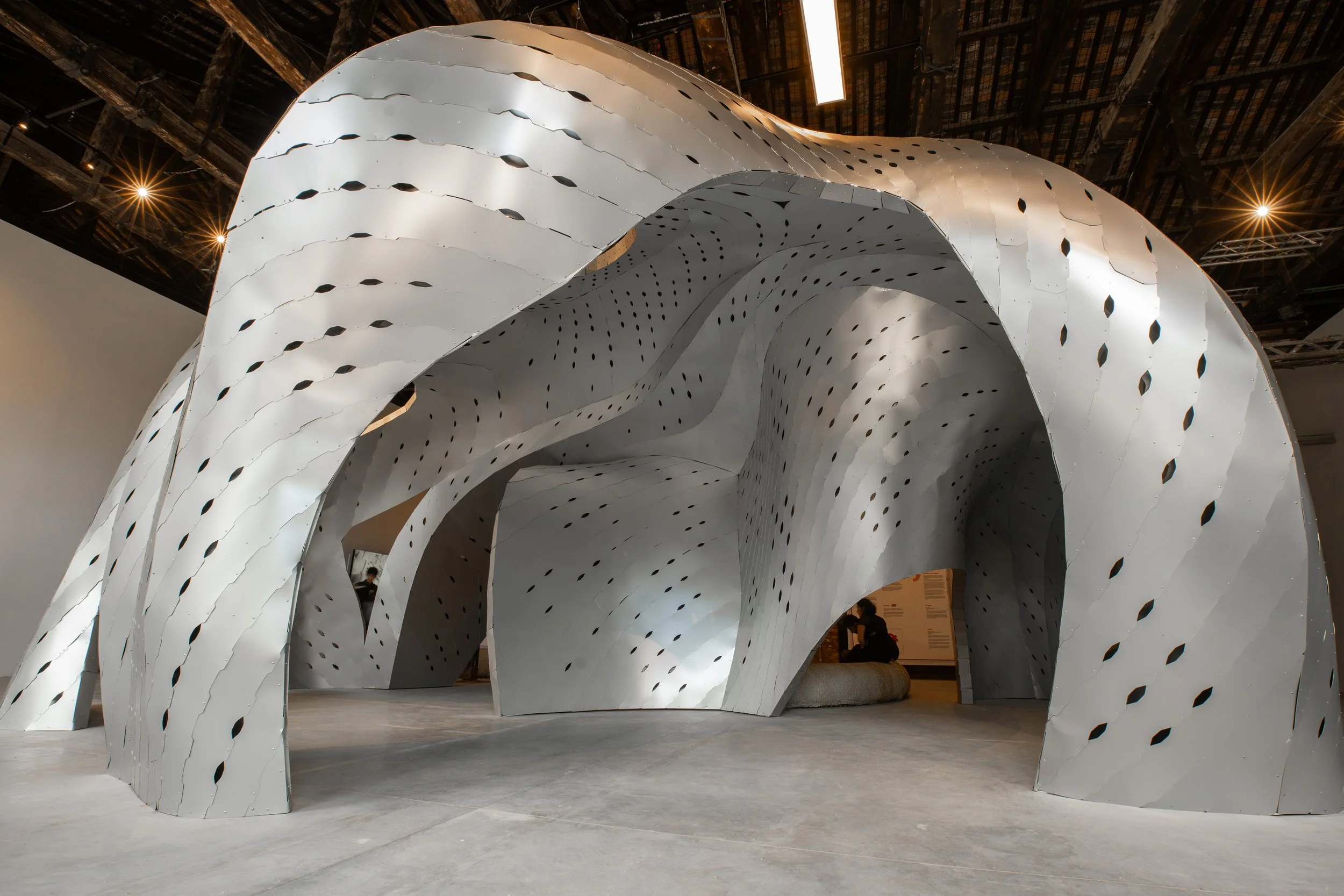The Sultanate of Oman opens its first-ever pavilion at the 19th International Architecture Exhibition – La Biennale di Venezia
Intelligens. Natural. Artificial. Collective., 19th International Architecture Exhibition – La Biennale di Venezia
The Sultanate of Oman marks its debut at the 19th International Architecture Exhibition of La Biennale di Venezia with Traces, curated by Omani architect Majeda Alhinai. The pavilion draws from the Sablah, Oman’s traditional communal gathering space, to present a powerful architectural proposition grounded in cultural continuity and spatial intelligence.
Traces is a space for hosting, gathering, and reflection. It draws on the logic of informal civic structures found across Oman and reframes them for contemporary public life. The Sablah is not used here as a reference or image. It operates as a method. Its spatial and social qualities, open circulation, shared presence, adaptability, and hospitality are translated into architectural terms. The pavilion applies this embedded logic to propose a new type of civic space that remains rooted in cultural specificity while addressing global questions of collectivity, reuse, and architectural responsibility.
Traces, Oman Pavilion I, Courtesy of Sultanate of Oman
The pavilion is built entirely from raw aluminum, formed through a custom system of folded and cut panels. Each panel features precision-cut perforations that derive from a catalog of patterns abstracted from Omani cultural practices, palm frond weaving, carved wooden doors, and the branching geometry of the Falaj irrigation system. These references are not aesthetic motifs. They operate as architectural instructions that shape light, space, and structure.
The entire assembly was conceived to be transported and reassembled in its entirety. Every component, from substructure to skin, has been designed for disassembly without material loss. The structure will be permanently installed in Oman following the Biennale, maintaining its scale and function as a civic space.
The form of the pavilion offers no fixed program. It is an open surface that invites occupation. There are no thresholds or enclosures, no singular axis of movement. Visitors pass through, linger, and gather. The curving geometry produces spatial variation, compression and release, exposure and enclosure without relying on conventional architectural boundaries. The architecture performs as a host, shaped by the same principles of hospitality and dialogue that define the Sablah.
Traces, Oman Pavilion I, Courtesy of Sultanate of Oman
The Sultanate of Oman at the 19th International Architecture Exhibition – La Biennale di Venezia
Arsenale - Venice
from Saturday, 10 May to Sunday, 23 November 2025
Commissioner: Sayyid Saeed bin Sultan bin Yarub Al Busaidi, Undersecretary of the Ministry of Culture, Sports and Youth for Culture
Curator: Majeda Alhinai
Exhibitors: Majeda Alhinai, William Virgil, Jalila Almamari, Abdullah Alrashdi, Ben Elmer, Ian Fennimore
For more information visit omaninvenice
About Majeda Alhinai
Majeda Alhinai, Traces Curator
Majeda Alhinai is an architect, designer, and educator whose multidisciplinary practice bridges architecture, art, and technology. She holds degrees from SCI-Arc and the University of Nottingham and has taught or served as a guest critic at institutions such as Kent State University, SCI-Arc, Misk Art Institute, Rensselaer Polytechnic Institute (RPI), Syracuse University, and Ohio State University. Majeda’s work explores themes of collective identity, emphasizing the dynamic relationship between people and space. Her projects have been exhibited regionally and internationally at prominent venues, including Hauser & Wirth, the A+D Museum, LACI, the SCI-Arc Gallery, Kent CAED, Armstrong Gallery, the Khaleeji Art Museum, and Stal Gallery, where she won the Grand Prize in the Young Emerging Artist exhibition. She is the co-founder of Brash Collective, a Los Angeles-based design agency. Majeda divides her time between Los Angeles and Muscat, continuing to shape innovative, human-centered spaces on a global scale through her independent and collaborative work.
Oman is making its debut at the Venice Architecture Biennale this year. What does this first-time participation represent for the country, and what message do you hope the Omani Pavilion will convey on the global stage?
Oman’s debut at the Venice Architecture Biennale is a landmark moment, one that marks a step in amplifying our cultural voice on the world stage. This first-time participation reflects our commitment to engaging in global conversations around architecture, heritage, and design.
We want to share Oman’s rich architectural legacy and evolving creative vision with an international audience. Through our pavilion, we aim to present a narrative that reflects both the depth of our traditions and the forward-looking spirit shaping our built environment today. More than just an exhibition, this is an opportunity to spark intercultural dialogue, foster collaboration, and connect Omani architects, designers, and thinkers with their counterparts from around the world. We hope our presence contributes meaningfully to a shared, global discourse on architecture and cultural identity.
This year’s Biennale theme is “Intelligens. Natural. Artificial. Collective.” How does Traces respond to, or challenge, these concepts?
Traces responds to the theme by proposing an architectural intelligence rooted in cultural memory rather than external technology. Taking the Sablah, Oman’s traditional gathering space, as a starting point, the pavilion reinterprets spatial practices shaped by climate, ritual, and collective behavior through contemporary design methods.
Instead of separating the natural from the artificial, the pavilion integrates them. Traditional Omani forms are abstracted and reimagined as architectural elements, allowing inherited knowledge to shape structure, movement, and atmosphere.
The pavilion’s openness and live responsiveness reflect a form of collective intelligence, where spatial meaning emerges through shared presence and interaction. As visitors move through the space, their presence subtly shapes it; echoing the way meaning in a Sablah is made through participation.
Here, intelligence is not a display of control but a mode of listening, where architecture becomes a vessel for shared memory, adaptation, and connection.
Traces, Oman Pavilion I, Courtesy of Sultanate of Oman
Traces, Oman Pavilion I, Courtesy of Sultanate of Oman
The pavilion centers around the traditional sablah. How did you approach reinterpreting this communal space for an international audience?
We approached the Sablah not as a typology to be displayed, but as a system of spatial intelligence. It is a space activated by gathering, consensus, and open-ended use—a civic condition rather than a built form. In Traces, this condition is reconstituted through architecture: an open aluminum structure that invites movement without dictating it, gathering without enclosure.
There are no thresholds or prescribed behaviors. The structure listens, holds, and adapts. It does not illustrate the Sablah, it enacts it.
This isn’t a cultural export or a replica of heritage. It’s a spatial proposition: that Omani ways of gathering can inform global models of architecture grounded in intimacy, adaptability, and shared presence.
Intended to be disassembled and reinstalled in Oman after the Biennale, Traces embraces adaptability and reuse. How does this approach reflect values within Omani architectural heritage, and what does it suggest about sustainable design moving forward?
Traces was designed with adaptability at its core. Its open structure invites movement, reflection, and gathering; drawing on the spirit of the Sablah as a space that evolves with its community. This flexibility is not just conceptual but practical: the entire Pavilion has been engineered for disassembly, transport, and reassembly without any need for re-fabrication, ensuring that nothing is wasted.
After the Biennale, it will be permanently reinstalled in Oman as a civic space, continuing its life beyond the exhibition. This approach reflects a principle of sustainability embedded in Omani traditions, where architecture is shaped by resourcefulness, environmental awareness, and long-term care. Traces contributes to the Biennale’s call for sustainable futures by proposing a model in which architectural intelligence is inseparable from cultural continuity.
Traces, Oman Pavilion I, Courtesy of Sultanate of Oman
The pavilion has no clearly defined inside or outside. How does this openness encourage interaction, and in what ways does it reflect values embedded in Omani culture?
The Pavilion’s openness creates a fluid space that encourages spontaneous interaction, gathering, and reflection. It has no fixed program, thresholds, or singular path; instead, its curved geometry produces a continuous surface where visitors can pass through, pause, or assemble as they choose. This sense of spatial freedom mirrors the principles of the Sablah, where hospitality, dialogue, and shared presence are central, while reflecting a core aspect of Omani culture: the importance of creating spaces that are not only functional but also generous, adaptable, and socially attuned.
Much of the pavilion’s form is drawn from traditional Omani objects and architectural details. Can you speak about how these cultural references were transformed through design—and how they became active elements in shaping the pavilion’s architecture?
The pavilion’s architecture is shaped not by referencing traditional Omani objects, but by working through them; translating their embedded intelligence into new spatial forms. Each element, whether a mandoos, khanjar, carved door, or mosque window, was studied for the principles it carries: protection, threshold, enclosure, ornament, and flow. These objects were then deconstructed and abstracted, shedding their symbolic identities to become tools for design.
Their transformation was not representational but operational. The curve of a dagger became a seating element that suggests directionality and pause. The symmetry of a carved door fractured into arcs that open and fold, redefining the notion of a threshold. The mandoos, once a vessel of protection, stretched and split to inform structural supports and volumetric grounding. The lattice of a window grille evolved into a porous shell; layered, curved, and inhabitable.
These forms, reinterpreted through digital modeling, guided the pavilion’s geometry and spatial experience. They do not mimic the past; they carry it forward through transformation.
Mandoos, elements of inspiration for the Omani Pavilion space and design
Floral patterns motifs, elements of inspiration for the Omani Pavilion space and design
Elements of inspiration for the Omani Pavilion space and design
Elements of inspiration for the Omani Pavilion space and design
You’ve spoken about architecture as a tool for fostering dialogue and social cohesion. How do you see Traces contributing to these conversations at the Biennale?
Traces contributes to conversations around dialogue and social cohesion by translating the spatial and social qualities of the traditional Omani Sablah, such as open circulation, shared presence, adaptability, and hospitality, into a contemporary architectural language. The Pavilion invites visitors to engage freely, gather informally, and inhabit the space on their own terms. In doing so, it becomes a platform for encounter and exchange, embodying the belief that architecture can foster connection, mutual understanding, and a sense of collective belonging.
As an architect, educator, and co-founder of Brash Collective, how has your multidisciplinary background shaped your approach to curating Traces?
My multidisciplinary background allowed me to approach Traces as more than just an architectural installation: it became a cultural project. As an architect, I considered form and function; as an educator, I thought about how knowledge and experience are communicated; and as a co-founder of Brash Collective, I brought a focus on research-led, socially engaged design. This fusion helped us frame the Pavilion as a living space of encounter that could bridge local specificity and global relevance, while drawing deeply from Omani cultural intelligence and translating it into a spatial and experiential language.
Traces, Oman Pavilion I, Courtesy of Sultanate of Oman
Traces, Oman Pavilion I, Courtesy of Sultanate of Oman
What were the most meaningful challenges or revelations in curating Oman’s first national pavilion at the Architecture Biennale? How has this experience influenced your own understanding of space and identity?
Curating Oman’s first national pavilion at the Biennale was both an honour and a responsibility. One key challenge was navigating how to represent a national identity without reducing it to visual symbols or static traditions. This led to a major revelation: that heritage is not about preservation alone, but about evolution. Through this process, I came to see space not just as a physical structure but as a container of memory, behaviour, and community. Traces taught me how architecture can become a cultural act, something that holds the past while enabling future forms of gathering, thinking, and being.
What do you hope Traces will inspire in both Omani citizens and international visitors during the Biennale and later, as the pavilion continues its journey in new contexts?
I hope Traces invites Omani citizens to see their architectural and cultural practices through a renewed lens. At the same time, I hope international visitors experience the Pavilion not as a representation of a distant culture, but as an invitation to reflect on their own notions of community, openness, and spatial responsibility.
About the Ministry of Culture, Sports and Youth
The Ministry of Culture, Sports and Youth of the Sultanate of Oman is the national authority responsible for shaping cultural and artistic policy. It plays a central role in representing Oman on the global stage through participation in international exhibitions, festivals, and cultural events. The Ministry is committed to preserving and promoting Omani heritage, fostering cross-cultural dialogue, and supporting artistic development. Its initiatives include the establishment and management of fine arts halls, galleries, and creative spaces, as well as the collection, documentation, and advancement of Oman’s artistic legacy at both national and international levels.



















